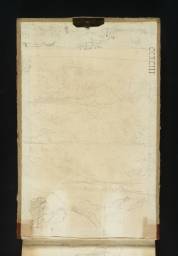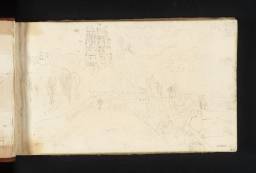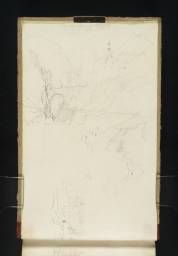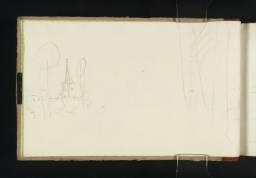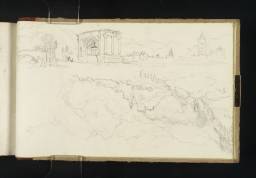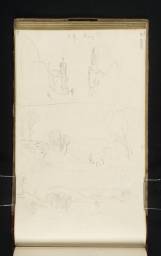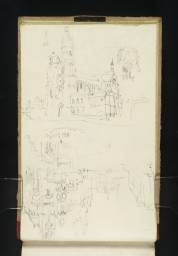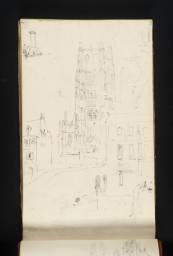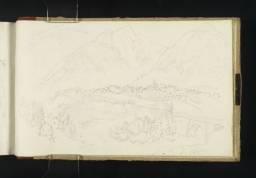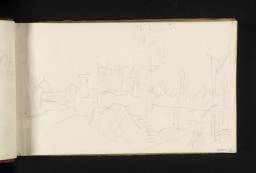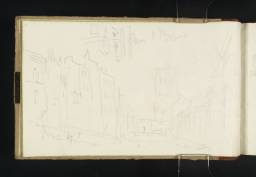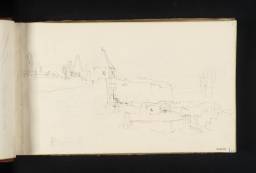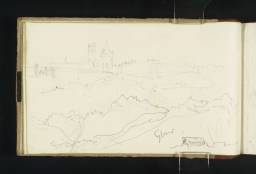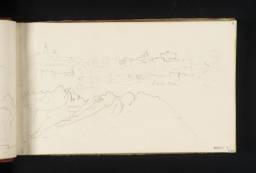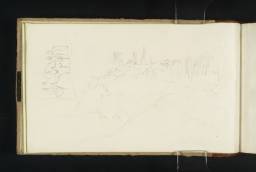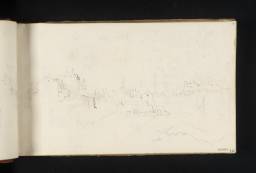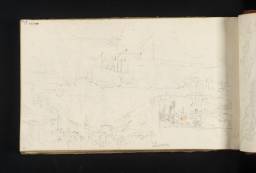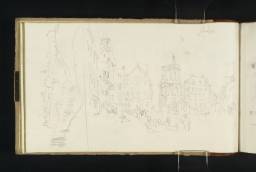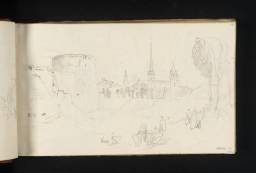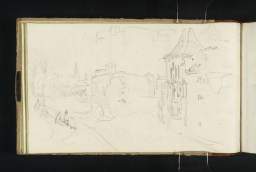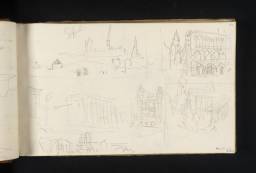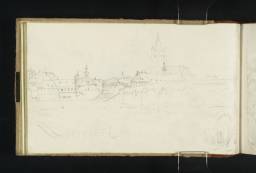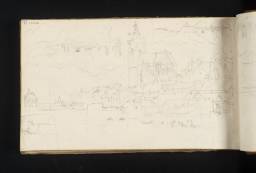Turner Bequest CCXCIII
Sketchbook, bound in plain buff boards, with brown leather spine, and one brass clasp, now broken, formerly attached to the back cover and a brass catch-plate affixed to the front
92 leaves of white wove paper
Approximate page size 113 x 190 mm
Watermarked ‘J JELLYMAN | 1828’
Inscribed faintly ?by Turner ink ink ?‘Vale...’ on front and perhaps back covers. Finberg noted a longer inscription by Turner on the front cover ‘Vale d’Aouste | Stratford upon Avon | 5 Leaves after France and Italy’, but this is no longer legible
Endorsed by the Executors of the Turner Bequest in ink ‘No. 320. Contains 90 Leaves | Pencil Sketches all on both Sides’ and signed in ink by Charles Turner ‘C Turner’ and initialled in pencil by John Prescott Knight ‘JPK’ and Charles Lock Eastlake ‘C.L.E.’ (the last two both now very faint) on front cover
Inscribed John Ruskin in blue ink ‘91 Leaves | and cover sketched | besides J.R.’ on front cover
Finberg recorded a further note by Ruskin, ‘55 of the leaves were lent to Oxford, as Extra Piece, No.2, Geneva Book’, but this not now present on either cover
Stamped in ink ‘CCXCIII’ on front cover, top right, and again on back cover, top left
‘I’, top left
92 leaves of white wove paper
Approximate page size 113 x 190 mm
Watermarked ‘J JELLYMAN | 1828’
Inscribed faintly ?by Turner ink ink ?‘Vale...’ on front and perhaps back covers. Finberg noted a longer inscription by Turner on the front cover ‘Vale d’Aouste | Stratford upon Avon | 5 Leaves after France and Italy’, but this is no longer legible
Endorsed by the Executors of the Turner Bequest in ink ‘No. 320. Contains 90 Leaves | Pencil Sketches all on both Sides’ and signed in ink by Charles Turner ‘C Turner’ and initialled in pencil by John Prescott Knight ‘JPK’ and Charles Lock Eastlake ‘C.L.E.’ (the last two both now very faint) on front cover
Inscribed John Ruskin in blue ink ‘91 Leaves | and cover sketched | besides J.R.’ on front cover
Finberg recorded a further note by Ruskin, ‘55 of the leaves were lent to Oxford, as Extra Piece, No.2, Geneva Book’, but this not now present on either cover
Stamped in ink ‘CCXCIII’ on front cover, top right, and again on back cover, top left
‘I’, top left
Accepted by the nation as part of the Turner Bequest 1856
Exhibition history
References
This sketchbook was used mainly in 1836 on a tour to the Alps and the Aosta valley. A few pages were used earlier, presumably c.1833, at Stratford-upon-Avon to make sketches towards a series of illustrations to the writings of Sir Walter Scott.
Starting at what is now numbered as the end of the book, Turner made a few studies of the riverside at Stratford, before sketching William Shakespeare’s birthplace in the town and his monument in Holy Trinity Church. The sketches of the latter formed the basis of a watercolour of Shakespeare’s Monument (untraced)1 engraved by J. Horsburgh and published in 1834 in The Prose Works of Sir Walter Scott. From the date of publication and allowing a few months for the plate to be engraved we may infer a date of 1833 at the latest for the visit to Stratford.
With only fifteen leaves drawn on at Stratford, the book was still largely empty, so in 1836 Turner took it with him on an Alpine tour in the company of Hugh Andrew Johnstone Munro of Novar.2 Munro’s reminiscences are the principal evidence for the date and itinerary of this tour (see Introduction: Sketchbooks used on Tour to the Alps, 1836). The sketches in the present book begin in northern France and record the tour as far as Aosta in Italy. The exact route is hard to deduce from the sequence of sketches because Turner used the book from both ends. The first sketches of the 1836 tour were made at St Omer near Calais, at the opposite end of the book to the Stratford sketches, at the beginning of the numbered sequence. Thereafter Turner opened the book almost randomly at either end, and although it is possible to pick out a geographic sequence for the subjects following (for example after St Omer he sketched at Bethune, Arras, Peronne, Ham, Laon, and Reims), they occur haphazardly.
Turner’s itinerary continued from Reims via Châlons-en-Champagne (formerly sur Marne), Vitry-le-François, St Dizier, Chaumont and Langres to Dijon and then via Dole to Lake Geneva. He toured the lake, it appears partly by steamer and partly by road, taking in Lausanne, Vevey, Montreux, Chillon, Villeneuve, St Gingolph and Meillerie, and finishing at Geneva where he made a comprehensive survey of the River Rhône down to its nearby junction with the River Arve. Thence he followed the Arve Valley up to Chamonix before taking the Col du Bonhomme route around Mont Blanc to Courmayeur and the Val d’Aosta. He finished the present book at Aosta and had obviously squeezed sketches into every available space as he neared the city.
At this point Turner took up a fresh sketchbook, the Fort Bard (Tate D29213–D29237; D29239–D29264; D29266–D29273; D29275–D29377; D41206–D41208; Turner Bequest CCXCIV) to record the remainder of the tour via Turin, Susa, the Mont Cenis Pass and Chambéry.
Technical notes
How to cite
David Hill, ‘Val d’Aosta sketchbook principally 1836’, sketchbook, June 2010, in David Blayney Brown (ed.), J.M.W. Turner: Sketchbooks, Drawings and Watercolours, Tate Research Publication, February 2014, https://www

